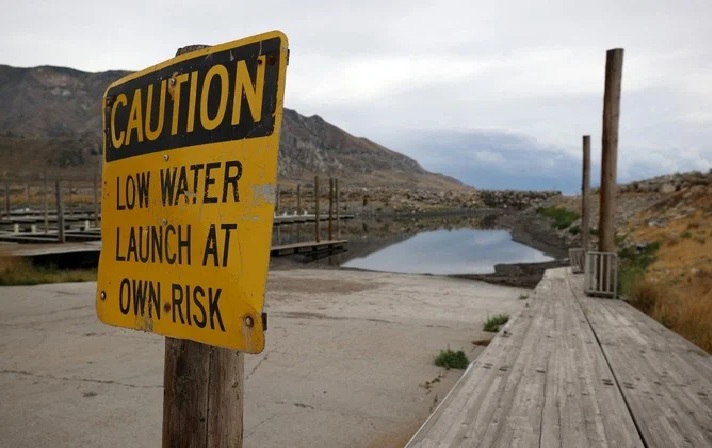Kerry Boyd Anderson
A new study published last month inspired headlines declaring that the Great Salt Lake in the US is at risk of drying up within five years. The famous lake is not the only saline lake facing disaster; many such bodies of water around the world are disappearing, with severe potential consequences. Saline lakes play important ecological, economic and cultural roles. Saline lakes are formed through a variety of means, but they usually lack an outlet to the sea and depend on a balance between incoming water and evaporation. This makes them particularly vulnerable to water diversion or changes in climate.
The January report warned that, if the Great Salt Lake’s current “rate of water loss continues, the lake would be on track to disappear in the next five years.” Some other US saline lakes, such as the Salton Sea, are at risk of disappearing, and others, such as Owens Lake, have already mostly vanished. Perhaps the most famous saline lake is the Aral Sea; previously the world’s fourth-largest lake, the Soviet Union’s massive water diversion for agriculture began to diminish the lake in the mid-20th century. Today, the Aral Sea is mostly gone, though efforts in Kazakhstan have helped to revive a section. Lake Urmia in Iran is a more recent example of another once-large lake disappearing; in the past 20-25 years, the lake has declined precipitously and faces potential extinction. In Iraq, Laka Sawa completely dried up in 2022; while some water has returned, the lake might not survive. Other lakes – including the famous Dead Sea, the enormous Caspian Sea and Turkiye’s Lake Van – are shrinking. While each lake is unique, there are similarities in the risks to their survival. In most cases, experts say that the main cause is overuse and poor management of water. One major factor is diverting water for agriculture; poorly planned agriculture can be particularly devastating, such as when it involves growing thirsty crops in arid regions and wasteful forms of irrigation. Water demands from growing populations is another problem for many lakes. Corruption and power struggles over water rights further complicate solutions.
Climate change plays a secondary but increasingly important role, as it threatens to decrease precipitation and increase heat and evaporation. The recent report on the Great Salt Lake noted that anthropogenic climate change has created “-4°F of warming in northern Utah since 1900” and estimated that climate change accounts for about 9 percent of the lake’s shrinkage. Iranian studies have suggested that 18 percent of Lake Urmia’s decline is due to climate change. When saline lakes shrink or disappear, the impacts can be enormous. Large saline lakes are critical components of their local climates. The Aral Sea was large enough to have a moderating impact on the region’s climate; since most of it disappeared, temperatures in the region have become more extreme. The Great Salt Lake’s evaporation contributes to precipitation in the region, including the snow that drives Utah’s winter tourism industry.
All of the lakes are important to ecosystems. Many of them support brine shrimp that some bird species rely on; some saline lakes are home to fish and other animals. As the lakes shrink and their salinity increases, many of the animals can no longer survive. Saline lakes are a part of local geology as well; in one example, the shrinking of the Dead Sea has created multiple sink holes in the region. The impacts on climate, ecology and geology affect the people who live around the lakes. Many lakes are the center of local economies, supporting fishing, aquaculture, tourism and sometimes mining. When they shrink or disappear, livelihoods go with them. Lakes often provide food directly through fishing and indirectly through water used for irrigation, so shrinking lakes can also reduce food supplies. Wind can spread salt, damaging soil. Communities also lose much of their recreation and cultural traditions when they lose lakes.
One of the most worrying impacts is on health. As saline lakes dry up, they expose lake beds that contain salt, other minerals and often pollutants from agricultural or industrial run-off. Winds lift those particles into the air. Multiple studies have shown that populations around such lakes see significant increases in respiratory illnesses, hypertension and other health problems. Some lakes contain additional dangers; for example, windstorms off the Great Salt Lake can contain arsenic. Many saline lakes can still be saved, but several – including the Great Salt Lake and Lake Urmia – require immediate action. Improving monitoring and studying of the lakes is important, but fundamentally the lakes need more water. There are many ideas for bringing more water to the lakes, and some have potential. However, transporting water from elsewhere often is very expensive and even impractical. Water conservation must be a part of saving saline lakes, which requires difficult decisions about reducing water to agriculture and population centers and sometimes negotiating with upstream authorities. For example, the recent report on the Great Salt Lake said that “30-50 percent reductions in water use may be required” – and quickly.
Residents around saline lakes and governments are increasingly aware of the problem. Some governments are taking action; for example, the US recently enacted a bipartisan bill to fund research into saline lake ecosystems, and Iran is working to implement plans to transfer water to Lake Urmia. However, in these and other cases, water conservation must also be quickly pursued, or the lakes could pass a tipping point and disappear.







